Echinopsis pachanoi
 Syn.: Trichocereus pachanoi
Syn.: Trichocereus pachanoi
Common name: San Pedro cactus
Family: Cactaceae
Origin: Andes of Peru, Ecuador, Bolivia and Chile
Description:
The plant is light to dark green, sometimes glaucous, and having 4-8 (usually 5-7) ribs. Groups of 1-4 small, yellow to light brown, spines are located at the nodes which are spaced evenly (approximately 2 cm apart) along the ribs. San Pedro can grow up to 5 meters tall and have multiple branches, usually extending from the base.
Cultivation:
San Pedro is very easy to grow in most areas. Because it grows naturally in the high altitude, high rainfall areas of the Andes, it can withstand temperatures far below that of many other cacti. In fact, its cultivation requirements are really more like 'normal' plants than most other cacti. San Pedro requires fertile, free-draining soil. They are susceptible to fungal diseases if overwatered, but are not nearly as sensitive as many other cacti, especially in warm weather. They can be sunburned and display a yellowing chlorotic reaction to overexposure to sunlight. In warm areas it is best to keep them out of direct sun in mid-summer.
|
|
|
In winter plants will etiolate, or become thin, due to lower levels of light. This may be problematic if the etiolated zone is not sufficiently strong to support future growth as the cactus may break in strong winds. Some people also find it visually undesirable. If you wish to avoid etiolation when temperatures drop and growth rates slow, encourage it to enter winter dormancy by withholding water and fertiliser from it over the winter.
The seeds are quite easy to germinate and grow. Their main requirements consist of high humidity levels, free-draining soil mix, and enough (but not too much) water, light, and nutrition. There are a number of commonly used methods that satisfy these requirements and the choice of a particular method depends mainly on the scale of the cultivation operation.
For soil, use coarse sharp sand (sieved river sand). Some people also find coir or peat, or mixtures, to be effective. The soil can be sterilised by cooking it in an oven on high for 1-2 hours. Sterilisation will be most effective if the sand is moist. The soil is placed into trays and the seeds planted into it (when the soil has cooled). The seeds should be only just below the surface (two or three sand grains over them). The trays now need to be kept in a humid environment. This may be achieved by the use of ziplock bags, glass plates, or greenhouses, depending on scale. Seeds usually germinate within two weeks two a month, but sometimes come up after several months.
The seedlings stay in the humid environment for several months. During this time they must be continually checked for water and nutrient requirements, and fungal pathogens. Ensure the soil stays moist, but not overly wet. Nutrients can be provided with a liquid fertiliser at 1/8th strength whenever growth rate slows down. Fungi can be killed with a sulfur or copper-based fungicide. There have been some reports of seedlings responding negatively to these treatments so be very cautious with the amount you use. There is some evidence that garlic is also an effective fungicide.
If germinating your seeds in cold weather, a heat mat and fluorescent light can be used.
Info:
San Pedro contains a number of psychoactive alkaloids, including the well-studied chemical mescaline. In most countries it is legal to cultivate San Pedro, but in countries where possession of mescaline and related compounds is illegal, cultivation for the purposes of consumption may be illegal. This is the case in the USA, Australia, Canada, and the UK, where it is currently legal to cultivate San Pedro unless it is for the purposes of consumption. It is unclear exactly how intent to consume would be proved. Possession of books, literature, and internet histories as well as large amounts of cactus (growing or not) may be enough evidence.
Articole asemănătoare
-
Plante de interior care tolereaza aerul uscat
O categorie de plante care nu doar tolereaza uscaciunea aerului, ci o prefera in detrimentul umiditatii, o reprezinta cactusii si suculentele.
-
Plante ce prezic cutremure si atrag undele electromagnetice
Exista multe ciudatenii in lumea plantelor si fascinatia oamenilor pentru lucrurile iesite din comun a facut ca unele plante sa primeasca atribute din cele mai stranii...
-
Echinopsis spachiana
Denumire populara: cereus, torta aurie. Sinonime: Trichocereus spachianus, Cereus spachianus, Echinocereus spachianus, Cereus santiaguensis, Echinopsis santiaguensis, Trichocereus santiaguensis. Familie: Cactaceae...
-
Metode de inmultire a plantelor de apartament
Marea majoritate a plantelor de apartament se inmultesc pe cale asexuata (vegetativa) - prin butasire, divizarea (despartirea) tufei, drajoni, stoloni, muguri adventivi, marcotaj, altoire...
-
Echinopsis pachanoi
Sin.: Trichocereus pachanoi Denumire populara: cactus San Pedro Familie: Cactaceae Echinopsis pachanoi sau cactusul de San Pedro este un cactus de culoare verde-inchis...

